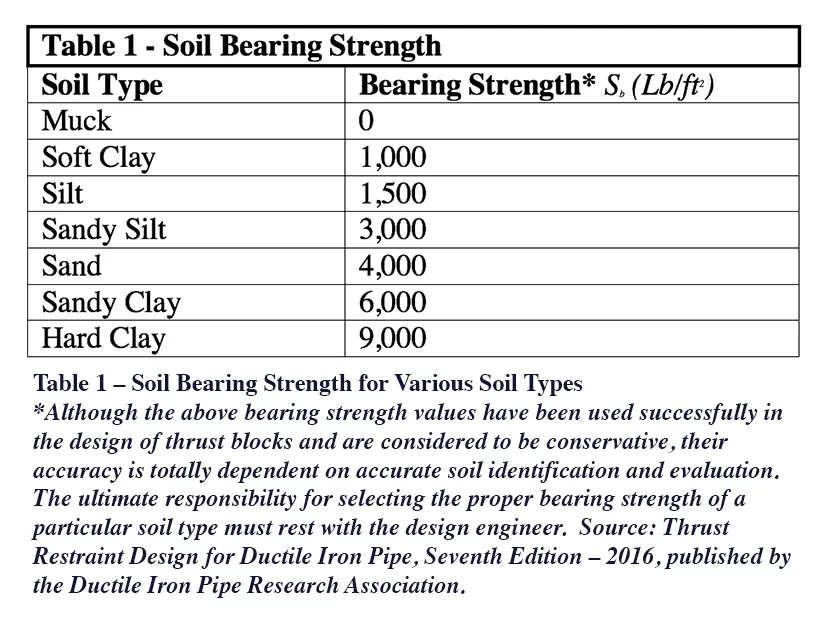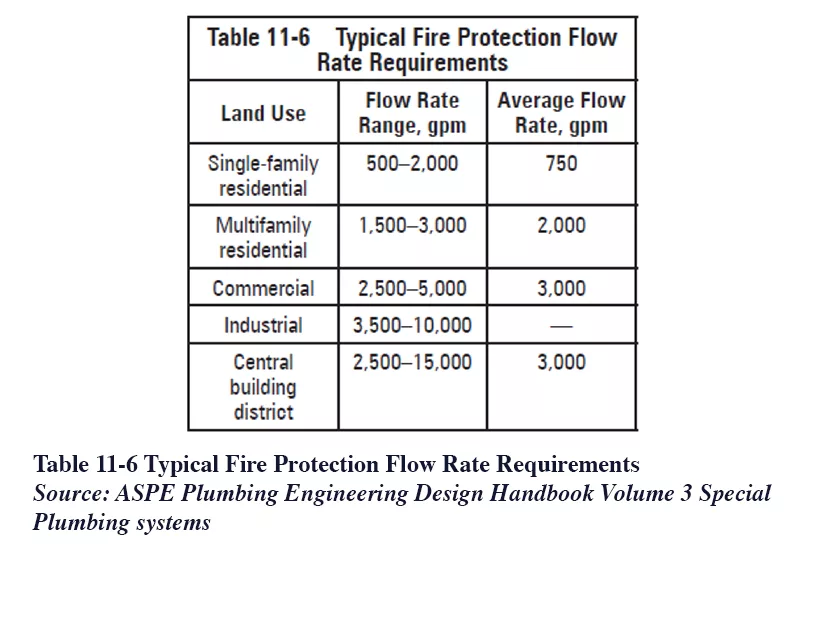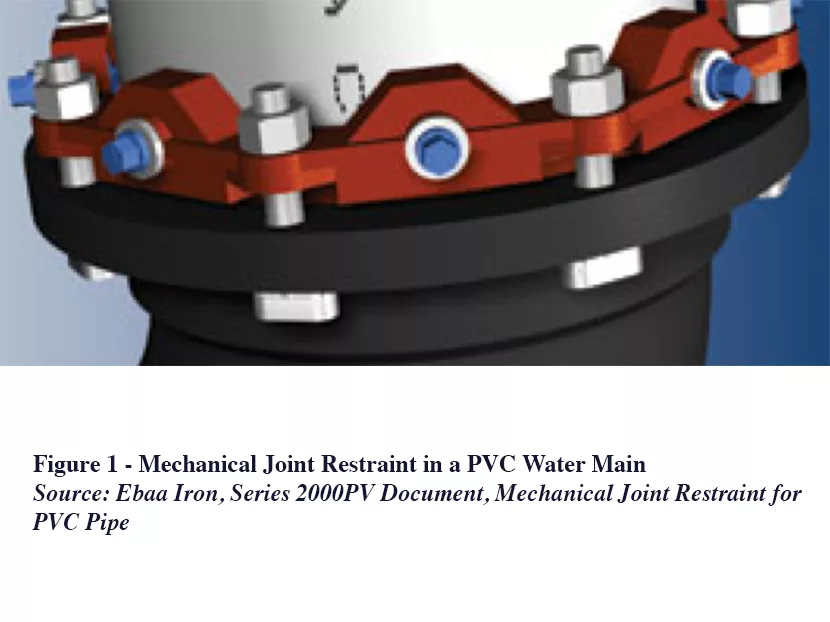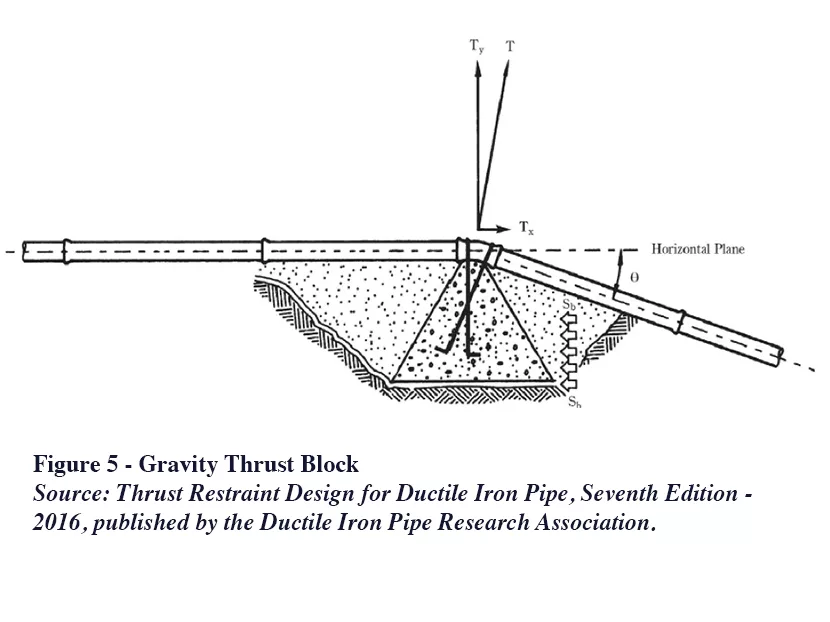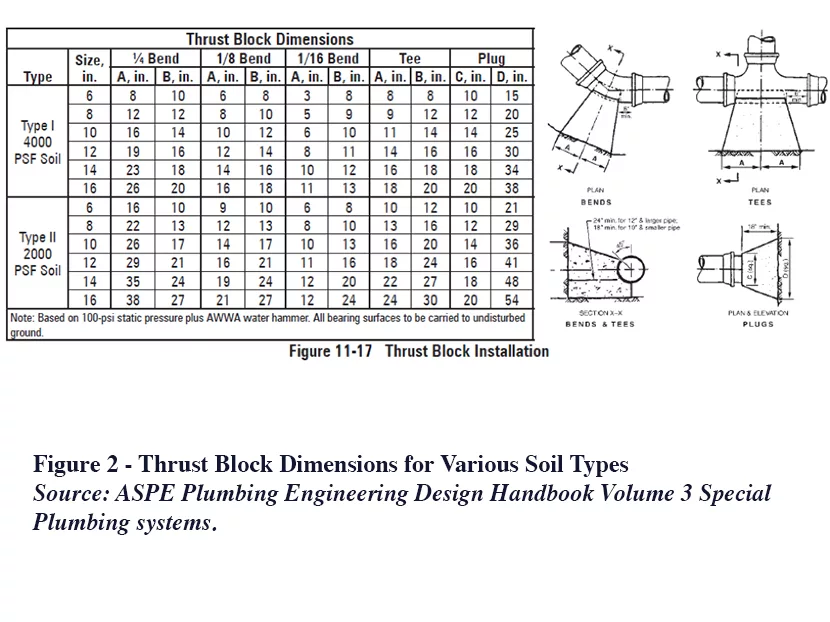Thrust blocks are concrete pipe thrust restraints or anchors placed up against underground pipe fittings to prevent movement of underground pipes from thrust forces in water mains. During fire flows or other similar flow events, a sudden, violent thrust force caused by the velocity and weight of the water acting on a fitting can cause it to pull away from the pipe resulting in joint separation.
I have served as a board member for a water and sewer department. I have also been a plumbing and fire protection design professional since 1978, and was a firefighter, EMT, and fire chief with 34 years in the volunteer fire service. I know that to calculate fire flows, you need to plug the fire flow rate into a calculation showing the water main size and then come up with a flow velocity. Next, you should calculate what the water hammer force would be when a firefighter shuts off a quarter turn butterfly valve. And finally, you should know the velocity and thrust forces for a water main during a fire flow event.
In recent years, water utilities have been using mechanical joint restraints for water mains without the use of thrust blocks. These restraints were originally developed for use with ductile iron water mains. Using mechanical joint restrains for cast iron or ductile iron pipe was promoted as a cheaper option than using concrete thrust blocks. Many water utilities have recently switched to PVC water mains as a less expensive material, which prompted the mechanical joint manufacturers to develop mechanical joint restraints for PVC piping. Many PVC pipe manufacturers recommend using concrete thrust blocks because mechanical joint restraints alone can impose stress on PVC pipe at the point that the set screws or wedge restrains make contact with it. These stress points can be the initiation point for stress cracks that lead to a piping failure if stresses are too high.
Thrust blocks
A thrust block prevents separation of joints from pipe movement by transferring the resultant thrust force at a fitting to the undisturbed soil behind the thrust block. The bearing strength of the soil is expressed in pounds per square foot. Therefore, the area behind the thrust block must engage enough soil to resist the resultant thrust force at a change in direction.
Thrust block design is commonly determined by the equation Ab=Sf*T/Sb.
Where:
Ab = the required bearing area of the thrust block,
Sf = the safety factor,
T = the resultant thrust force (from the manufacturer’s info.), and
Sb = the bearing strength of the soil.
Combining thrust blocks and mechanical joint restraints
Thrust blocks and mechanical joint restraints should both be included when designing the piping system for a fully restrained installation. A combined system will yield more protection from failure of the piping when underground water systems are exposed to water hammer or thrust forces. It is often poor practice to mix systems based on each being designed to resist a percentage of the resultant thrust force. Both thrust blocks and mechanical joint restraints can allow slight movement before the teeth of the restraint engage for a mechanical joint restraint or the soil compresses with a concrete thrust block. Their maximum thrust restraint capability must be calculated based on the maximum potential thrust force in a water main.
Mechanical joint restraints
Mechanical joint restrains use a push-on type flange and a gasket to make a watertight seal on a water main and they incorporate set screws or clamping devices for the flange to grab onto the outside diameter of the pipe to prevent it from separating from the ductile iron fitting socket.
Mechanical joint restraint design methods
Current mechanical joint restraint manufacturers have two restrained joint design methods for different pipe materials. These methods depend on two primary forms of mechanisms to resist the unbalanced thrust forces that arise at a horizontal or 90-degree offset in the piping, or at a valve, tee or other similar source of resistance to water pressure thrust forces in a buried pressure pipeline. The first and most commonly recognized design is from friction and adhesion resistance along the outside of the pipe where the pipe and soil interface. The second design method is using passive and/or bearing resistance of the pipe against the soil surrounding it. The type of engineered backfill around a water main may control what this resistance to thrust forces can be. This cannot be accounted for in piping aboveground without significant pipe anchors and supports with restraints. For this reason, mechanical joint restraints are generally not recommended aboveground without special consideration for this condition.
Where changes in pipe direction occur, pressure is exerted by the flowing water on the interior surface of the fitting and pipe at changes in direction. This interior pressure is known as thrust force. The joints alone may not provide sufficient resistance to the force exerted by the pressure of the water against the fitting. To prevent joint failure due to the pressure exerted, most pipe joints must be restrained in some manner. Mechanical joint restraint manufacturers rely on the additional restraint provided by the friction resistance and the density of the soil around the pipe. If the piping is installed in a mucky or (wet) soft clay application, the soil may not provide much resistance to movement.
Using mechanical joint restraints in lieu of concrete thrust blocks is done to save money on the materials and labor. Often mechanical joint restraints are installed in systems where the thrust forces can easily exceed the capability of the holding strength of the set screws in the piping system during the extreme flow or a fire condition. These joints should be designed for the worst-case scenario, not an average flow condition.
Mechanical joints with set screws and push-on joints or slip-on flanges are sealed by a rubber-type gasket compressed in a space between the spigot end of the pipe and the bell or adapter flange. These joints will not fully resist the thrust force of the water at a change in direction for the reason explained above. The common method of restraint used on water mains are: anchors, thrust blocks, external clamps with tie-rods and mechanical joint restraints. Mechanical joint restraints should not be used alone, unless an engineer has calculated the maximum possible fire flows and thrust forces and taken samples of the soil used as backfill in the utility trench. The undisturbed soil cannot be used for calculating mechanical joint restraints, because the pipe should not be in contact with the undisturbed soil if it is bedded in accordance with the specifications. Friction clamps are sometimes bolted around the pipe on both sides of mechanical joints when thrust is evaluated and determined to be a concern. These friction clamps engage steel tension rods, sometimes called tie-rods, across the joint, preventing it from separating. This will combine the resistance of these joints to prevent separation. Calculations are necessary to determine the maximum potential thrust force based on the service of the water line and the offset or the actual number of joints to be restrained. I have not seen any calculations for this installation, however, a calculation shows the thrust forces exceed the values allowed by this product type.
Water main failure investigations
I have recently investigated several water main failures where they were not designed or installed properly, and it resulted in failures because of mechanical joint separations. The intent of this article is not to say mechanical joints are bad; it is to point out they need to be designed and installed in accordance with the conditions they will be expected to see in a fire flow or other thrust event.
Some joint failures have been on water mains after they enter a building and a mechanical joint restraint is used aboveground inside the building. These types of joints are not recommended for unrestrained, aboveground applications where excessive water hammer forces can cause joint failures and extensive water damage.
I have also seen mechanical joint restrains used on PVC pipe as it enters a building connecting to the piping or the main building shut-off valve within the building. In cases where there were extreme thrust forces, there have been failures. There must be additional thrust blocking, anchors or restraints to resist the pull-out of the transition joint from PVC to ductile iron or other material within the building.
When an extreme force, beyond the capability of the mechanical joint restraint force is exerted, it will pull out leaving scratch marks or stress cracks in the pipe. These interior joints, without additional thrust restraints have been known to fail and when they do, it is usually on the utility side of the building isolation valve. This usually exposes the mechanical room or the entire basement to flooding.
Other failures have been in water mains under streets where concrete thrust blocks were not installed and improper bedding and backfill and tightening of bolts on the underside of the water mains are difficult to do in freezing winter conditions with water in the excavation. Relying on only mechanical joint restraints without additional thrust blocking or pipe supports has led to many water main failures.
Another failure occurred after a large water main construction project was completed that included miles of piping under city streets. When it was time to introduce water into the system, the large water diameter main was fully opened to allow water to rush into the empty water main pipes resulting in extreme thrust and water hammer forces at fittings and ends of the system. This resulted in numerous water main failures at the same time and many sinkholes developed in freshly paved roadways shortly after opening the main water valve. This happened because they did not slowly fill the water mains to prevent the water hammer pressure surges. Thrust pull-out forces were calculated well in excess of 100,000 pounds of force at the mechanical joint restraints, which were rated around 75,000 pounds of pull-out force resistance. This shows the mechanical joint restraint cannot withstand the worst case thrust force. Therefore, in this example, concrete thrust blocks should be used to supplement the mechanical joint restraints.
Belts & suspenders
Mechanical joint restraints use a friction grip much like suspender clips that grab onto a pair of pants. A mechanical joint restraint has set screws that make a friction grip onto a pipe. Thrust blocks, on the other hand, are more like a tight belt. Belts have traditionally been used to go above the waist and rest on the hips to keep the belt and the pants from falling down. A concrete thrust block placed behind an elbow or tee in a piping system is a very reliable way of preventing thrust forces from moving a water main and causing a pipe joint to separate. Concrete thrust blocks are like belts, and mechanical joints are like suspenders. Using both is better than using just one.
Many water utilities have been using mechanical joint restraints without concrete thrust blocks to save money.
Regardless of the mechanical joint restraint design, they all function in a way that grabs the pipe with a friction grip, and then releases it with less pull-out force than the force required for a properly placed concrete thrust block behind a pipe fitting.
When mechanical joint restraints are used without concrete thrust blocks, there is a potential for water main failure if the installation is not done to specifications or if the maximum thrust restraint pull-out forces exceed the pull-out forces specified.
It is common for water utilities to make repairs in winter months where conditions are less than desirable and access to the set screws is difficult at best. I have witnessed many failures because of a desire to save a few dollars on concrete thrust blocks. Using suspenders without a belt to hold up your pants is not a wise choice if your job requires you to fill your pockets with heavy tools and jump down into a ditch. The weight of the tools and the height of the jumping is comparable to the water flow velocity and water pressure in the water main. The higher you jump; the more force is exerted on your suspender clips. The more tools in your pocket, then additional forces are exerted on the suspender clips and you will have a greater chance that your suspenders will pull loose, and your pants will fall down. The jumping height and weight of the tools is like excessive water velocity and pressure being exerted on a mechanical joint restraint fitting. When there is a joint failure with a water main, there are usually news cameras and headlines showing broken water mains, water bubbling up from the pavement, sinkholes, boil water advisories and bacteria introduced into the water main during construction.
Some mechanical joint restraint manufacturers publish the pull-out resistance forces for their products in many sizes at a given pressure of about 100 psi. Since water hammer thrust forces commonly exceed many hundreds of pounds of pressure, the designer must account for that that pull-out force by calculating for the anticipated thrust force pressure and performing a correction calculation as described in the manufacturer’s published literature. Every installation should be checked by the design professional to verify that the thrust forces and potential water hammer pressures are within the limit of the joint method being used based on the fire flows for the building types in the area.
For a water system that is reliable, I would recommend using both a mechanical joint restraint and a concrete thrust block at all changes in directions of a water or fire main in a critical facility where a joint separation could cause a considerable disruption including a foundation or roadway damage. Mechanical joints that have separated inside buildings can quickly flood a building before the shut-off valve can be located. In some recent failures in basements and utility tunnels, the piping system was not properly restrained, and nearby firefighting operations caused thrust forces that separated the mechanical joint restraints causing the basement, adjoining tunnel and all of the dozens of connected buildings to flood. Imagine the cost of loss of business, cleanup, and expedited purchase and overtime for replacement of flooded mechanical and electrical equipment in basement mechanical rooms.
Owners and water utilities should require engineers to perform hydraulic thrust force calculations to determine what the potential thrust forces can be for the water mains with fire flows and assure the thrust forces are within the limits of the mechanical joint restraint system being used. In addition, the installation requires the set screws to be torqued to the specified level. The field engineer or construction inspector should witness or perform torque tests on the restraint bolts as part of the installation process. As a plumbing design professional, a former water utility board member and as a firefighter, I knew what the potential fire flow and thrust forces could be for a large structure fire. The National Fire Protection Association NFPA 24: Standard for the Installation of Private Service Mains and their Appurtenances requires the velocity force to be calculated. The ASPE Plumbing Engineering Design Handbooks give design flows that should be considered for various building types for purposes of considering water main sizing.
For example, a commercial building project has fire flows listed as 3,000 gpm in table 11.6. At 3,000 gpm, the flow velocity would be about 13 feet per second (fps) in a 10-inch water main. To quickly determine the potential water hammer pressure spike, multiply the water velocity by 60. Therefore: 13 fps x 60 = 780 psi above the static pressure if a quick-closing butterfly valve on a fire truck was closed. To convert to thrust pull-out force we would refer to the manufacturer’s charts for a thrust pull-out force number at a given pressure of 100 psi. In this example, the manufacturer shows a thrust force of 13,685 at 100 psi and there is a note to adjust for the actual pressure. The actual pressure was 780 psi or a multiple of 7.8 times 100 psi. Therefore: 7.8 x 13,685 = a thrust force of 106,743 pounds of force or 53.3 tons of thrust force.
For comparison, a fully loaded double trailer semi-truck typically weighs about 53.3 tons. Water moving at 13 feet per second would place a pull-out thrust force on the elbow similar to the force of a double trailer semi-truck crashing into the elbow at a speed of 8.86 miles per hour. (13 feet per second = 8.86 miles per hour). That would be significant physical force exerted on a friction restraint set screw (suspenders). Another design option is to consider a larger water main to reduce the flow velocity or require concrete thrust blocks even if there are mechanical joint restraints on the water main. Think about the havoc it could cause for firefighting operations if the water mains fail during a fire event.
Thrust block design
The design of a thrust block involves consideration of undisturbed soil, soil bearing strength, anticipated thrust pressure, pipe size, fitting configuration, and trench depth to determine the bearing area of the thrust block.
When designing or installing a thrust block, care should be taken to prevent the concrete from covering the joints at the fittings, the weep holes of the hydrants, and the operating mechanisms of valves.
Once the thrust block is properly designed and formed, a concrete truck is called to the site to place the concrete. Now the wait begins. The concrete must dry before the pipe is charged with water and tested. This procedure addresses horizontal fittings. When complicated bend combinations, vertical down-bends, parallel lines, dead ends, and future excavation possibilities become involved, the use of thrust blocks becomes very problematic. This report does not begin to explore the complications involved with thrust blocks in locations with poor soil conditions.
Good design practices
I have sat in seminars and had discussions with many engineers who say they can’t do something because their client will not accept that. I say they had better have good errors and omissions insurance because that is a recipe for disaster. Remember the client hires the design professional because they should know how to design the system to perform without pre-mature failure. If a design professional has a client that demands that you design something in a particular way that goes against good design or health and safety, you should push back and explain the situation. Remember the design professional seal and reputation is on the line, not the owners. Document your concerns with the client in writing. If they still insist, ask them to indemnify you and relieve you of any liability associated with that concept in writing. If they refuse to do so, design the system following good engineering practices and if they choose to make changes or alterations, the liability is not on you as the design professional. Following good design practices, like installing mechanical joint restraints with concrete thrust blocks will provide for years of trouble-free service for water mains. Whether you choose to design the system with mechanical joint restraints, concrete thrust blocks or both, make sure you calculate for the worst-case scenario and document it, so you don’t get caught with you pants down.
